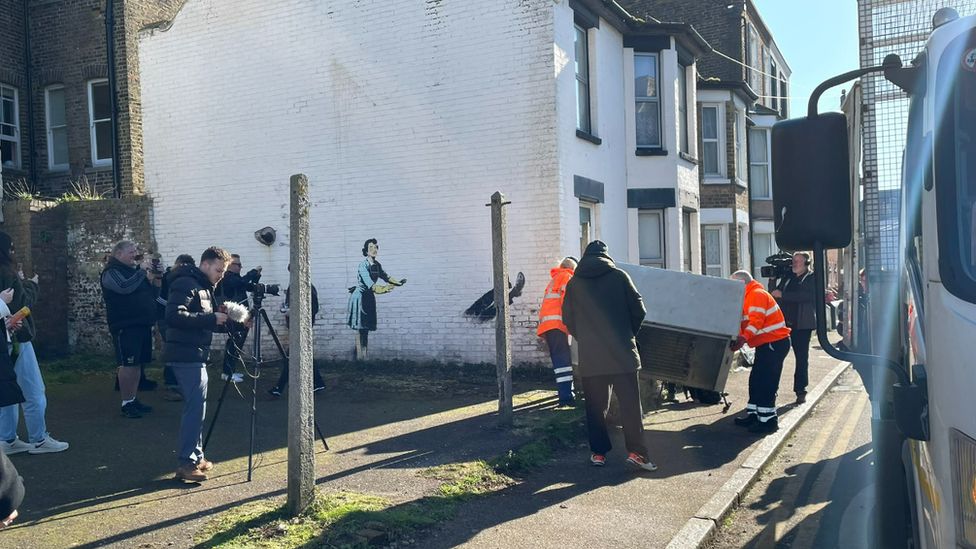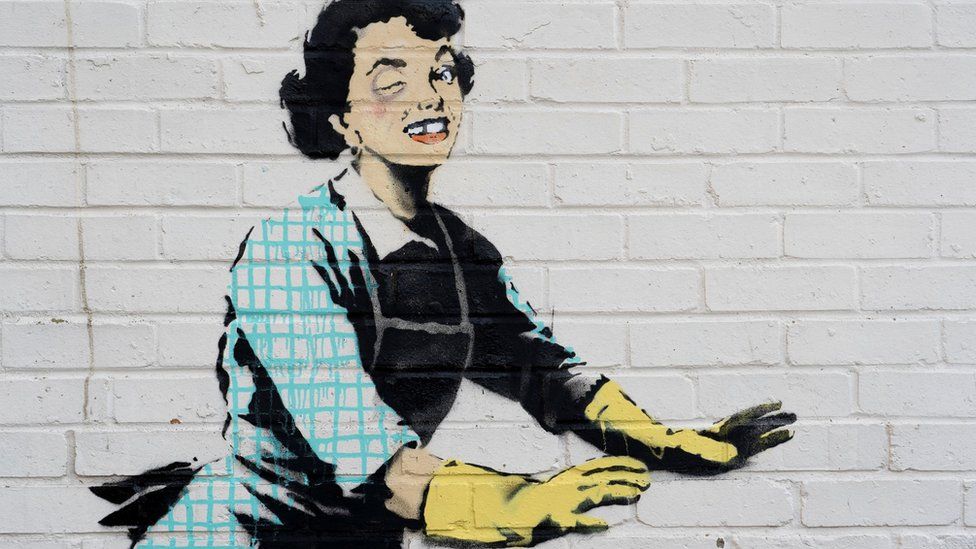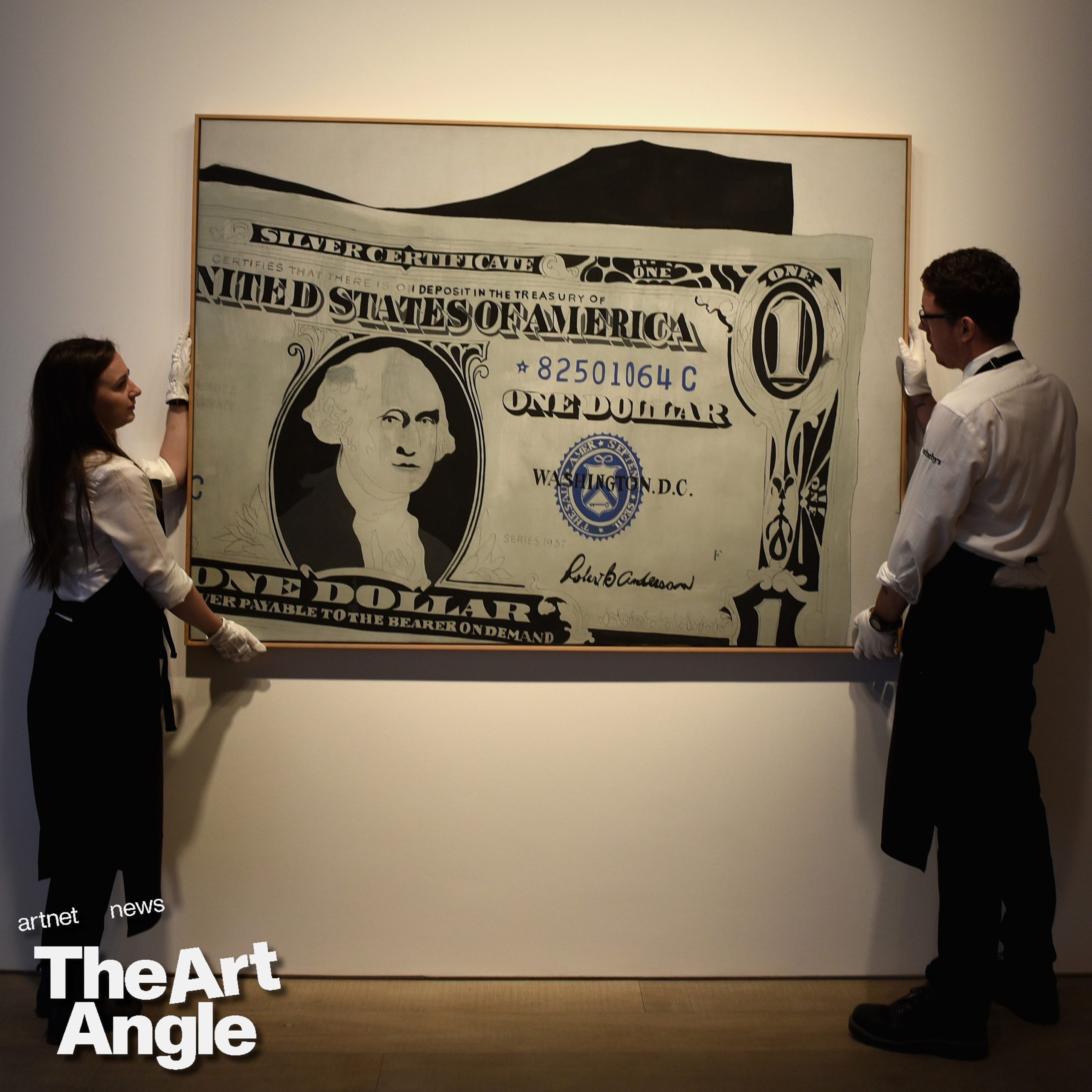Art
Banksy Margate Valentine’s Day artwork has piece removed within hours
|
|
A Banksy artwork that appeared in Margate has been dismantled by the local council hours after the elusive artist claimed the piece as his.
The mural shows a 1950s housewife with a swollen eye and missing tooth, apparently shutting a man in a freezer.
The piece – called “Valentine’s day mascara” by Banksy – had also incorporated a broken freezer and other items, which were all later removed.
A statement from Thanet District Council added: “A fridge freezer which is believed to have been part of the installation has been removed by council operatives on the grounds of safety as it was on public land.”
Banksy published a picture of the work on his Instagram page on Valentine’s Day morning, and many of the comments suggest he is referencing fighting violence against women.
The artist also posted pictures showing a close-up of the woman’s smiling, but seemingly battered face.
The artwork also featured a variety of rubbish on the ground, including a broken white garden chair, a blue crate and an empty beer bottle.
Watch: People seen taking away Banksy artwork freezer
The resident of the property where the painting was created, who asked not to be named, said the freezer and other items had been removed “very quickly” and put into a truck at midday on Tuesday.
Discussing how she felt about the removal, the tenant said: “I’m absolutely upset because it’s not really nice. It was part of the art, they should be very happy because Margate could get bigger attention, positive attention.
“Why did they move those parts? It’s just silly.”
Referring to the council, she added: “Earlier, no-one was interested if the rubbish was on the street. I mean, they were, but not that quickly.
“Even if you report something to them about taking the rubbish, they are acting one or two weeks later, not immediately.”

Many local Margate residents commented on the removal of the freezer on social media, with some accusing the council of spoiling the artwork.
Among them was Richard Llewellyn, who said: “The alley, a public footpath that leads almost to where the Banksy art piece is, has been like this for weeks and weeks. It’s shocking what is in the pile.
“Yet the council can arrive as quick as anything to remove part of the artwork 200 metres away. Someone’s priorities a little wrong me thinks.”
Another comment said: “Probably been there for months….only became a health and safety issue once it became a piece of art.”
The council said the fridge freezer “is now in storage and will be returned once it has been made safe to the public”.
The statement added: “We will be contacting the owner of the property to discuss the options to preserve the artwork for the district.”
Banksy has previously created artwork for Valentines Day, including a piece which appeared three years ago in Bristol, the reputed home city of the artist.


In December, Banksy created 50 screenprints which are to be sold to raise funds for a charity supporting the people of Ukraine.
The anonymous graffiti artist previously confirmed he had spent time in Ukraine after posting a video of an artist spray-painting designs in the war-torn country and speaking to locals.


Follow BBC South East on Facebook, on Twitter, and on Instagram. Send your story ideas to southeasttoday@bbc.co.uk.





Art
Art and Ephemera Once Owned by Pioneering Artist Mary Beth Edelson Discarded on the Street in SoHo – artnet News
This afternoon in Manhattan’s SoHo neighborhood, people walking along Mercer Street were surprised to find a trove of materials that once belonged to the late feminist artist Mary Beth Edelson, all free for the taking.
Outside of Edelson’s old studio at 110 Mercer Street, drawings, prints, and cut-out figures were sitting in cardboard boxes alongside posters from her exhibitions, monographs, and other ephemera. One box included cards that the artist’s children had given her for birthdays and mother’s days. Passersby competed with trash collectors who were loading the items into bags and throwing them into a U-Haul.
“It’s her last show,” joked her son, Nick Edelson, who had arranged for the junk guys to come and pick up what was on the street. He has been living in her former studio since the artist died in 2021 at the age of 88.
Naturally, neighbors speculated that he was clearing out his mother’s belongings in order to sell her old loft. “As you can see, we’re just clearing the basement” is all he would say.


Photo by Annie Armstrong.
Some in the crowd criticized the disposal of the material. Alessandra Pohlmann, an artist who works next door at the Judd Foundation, pulled out a drawing from the scraps that she plans to frame. “It’s deeply disrespectful,” she said. “This should not be happening.” A colleague from the foundation who was rifling through a nearby pile said, “We have to save them. If I had more space, I’d take more.”
Edelson’s estate, which is controlled by her son and represented by New York’s David Lewis Gallery, holds a significant portion of her artwork. “I’m shocked and surprised by the sudden discovery,” Lewis said over the phone. “The gallery has, of course, taken great care to preserve and champion Mary Beth’s legacy for nearly a decade now. We immediately sent a team up there to try to locate the work, but it was gone.”
Sources close to the family said that other artwork remains in storage. Museums such as the Guggenheim, Tate Modern, the Museum of Modern Art, the Brooklyn Museum, and the Whitney currently hold her work in their private collections. New York University’s Fales Library has her papers.
Edelson rose to prominence in the 1970s as one of the early voices in the feminist art movement. She is most known for her collaged works, which reimagine famed tableaux to narrate women’s history. For instance, her piece Some Living American Women Artists (1972) appropriates Leonardo da Vinci’s The Last Supper (1494–98) to include the faces of Faith Ringgold, Agnes Martin, Yoko Ono, and Alice Neel, and others as the apostles; Georgia O’Keeffe’s face covers that of Jesus.


A lucky passerby collecting a couple of figurative cut-outs by Mary Beth Edelson. Photo by Annie Armstrong.
In all, it took about 45 minutes for the pioneering artist’s material to be removed by the trash collectors and those lucky enough to hear about what was happening.
Dealer Jordan Barse, who runs Theta Gallery, biked by and took a poster from Edelson’s 1977 show at A.I.R. gallery, “Memorials to the 9,000,000 Women Burned as Witches in the Christian Era.” Artist Keely Angel picked up handwritten notes, and said, “They smell like mouse poop. I’m glad someone got these before they did,” gesturing to the men pushing papers into trash bags.
A neighbor told one person who picked up some cut-out pieces, “Those could be worth a fortune. Don’t put it on eBay! Look into her work, and you’ll be into it.”
Follow Artnet News on Facebook:
Want to stay ahead of the art world? Subscribe to our newsletter to get the breaking news, eye-opening interviews, and incisive critical takes that drive the conversation forward.
Art
Biggest Indigenous art collection – CTV News Barrie
[unable to retrieve full-text content]
Biggest Indigenous art collection CTV News Barrie





Source link
Art
Why Are Art Resale Prices Plummeting? – artnet News


Welcome to the Art Angle, a podcast from Artnet News that delves into the places where the art world meets the real world, bringing each week’s biggest story down to earth. Join us every week for an in-depth look at what matters most in museums, the art market, and much more, with input from our own writers and editors, as well as artists, curators, and other top experts in the field.
The art press is filled with headlines about trophy works trading for huge sums: $195 million for an Andy Warhol, $110 million for a Jean-Michel Basquiat, $91 million for a Jeff Koons. In the popular imagination, pricy art just keeps climbing in value—up, up, and up. The truth is more complicated, as those in the industry know. Tastes change, and demand shifts. The reputations of artists rise and fall, as do their prices. Reselling art for profit is often quite difficult—it’s the exception rather than the norm. This is “the art market’s dirty secret,” Artnet senior reporter Katya Kazakina wrote last month in her weekly Art Detective column.
In her recent columns, Katya has been reporting on that very thorny topic, which has grown even thornier amid what appears to be a severe market correction. As one collector told her: “There’s a bit of a carnage in the market at the moment. Many things are not selling at all or selling for a fraction of what they used to.”
For instance, a painting by Dan Colen that was purchased fresh from a gallery a decade ago for probably around $450,000 went for only about $15,000 at auction. And Colen is not the only once-hot figure floundering. As Katya wrote: “Right now, you can often find a painting, a drawing, or a sculpture at auction for a fraction of what it would cost at a gallery. Still, art dealers keep asking—and buyers keep paying—steep prices for new works.” In the parlance of the art world, primary prices are outstripping secondary ones.
Why is this happening? And why do seemingly sophisticated collectors continue to pay immense sums for art from galleries, knowing full well that they may never recoup their investment? This week, Katya joins Artnet Pro editor Andrew Russeth on the podcast to make sense of these questions—and to cover a whole lot more.
Follow Artnet News on Facebook:
Want to stay ahead of the art world? Subscribe to our newsletter to get the breaking news, eye-opening interviews, and incisive critical takes that drive the conversation forward.
-
Media16 hours ago
DJT Stock Rises. Trump Media CEO Alleges Potential Market Manipulation. – Barron's
-
Media18 hours ago
Trump Media alerts Nasdaq to potential market manipulation from 'naked' short selling of DJT stock – CNBC
-
Investment17 hours ago
Private equity gears up for potential National Football League investments – Financial Times
-



 Sports21 hours ago
Sports21 hours ago2024 Stanley Cup Playoffs 1st-round schedule – NHL.com
-
News15 hours ago
Canada Child Benefit payment on Friday | CTV News – CTV News Toronto
-
Real eState9 hours ago
Botched home sale costs Winnipeg man his right to sell real estate in Manitoba – CBC.ca
-
Business17 hours ago
Gas prices see 'largest single-day jump since early 2022': En-Pro International – Yahoo Canada Finance
-
Art20 hours ago
Enter the uncanny valley: New exhibition mixes AI and art photography – Euronews




